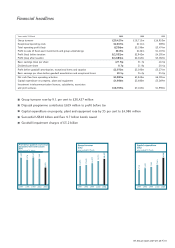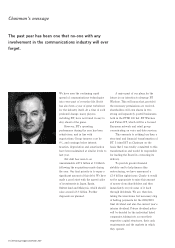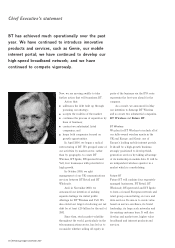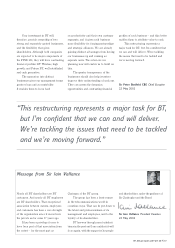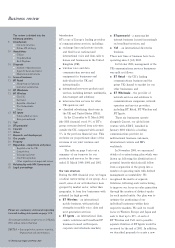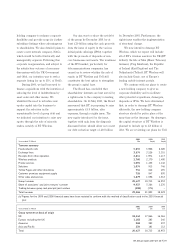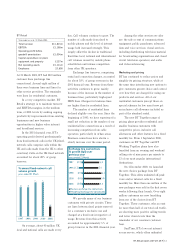BT 2001 Annual Report Download - page 13
Download and view the complete annual report
Please find page 13 of the 2001 BT annual report below. You can navigate through the pages in the report by either clicking on the pages listed below, or by using the keyword search tool below to find specific information within the annual report.
BT Annual report and Form 20-F 13
Transfer Mode (ATM) switching,
by March 2002, again potentially doubling
the capacity of each switch.
We are upgrading our network to
meet the growing demand for bandwidth.
We believe that BT is ahead of similar
European operators in large-scale
deployment of high-capacity Synchronous
Digital Hierarchy (SDH) and Wavelength
Division Multiplexing (WDM) technology.
We are also upgrading our exchange-
based switches to provide carrier pre-
selection (CPS). This enables customers to
pre-select an alternative carrier for their
calls without having to dial additional
access codes. CPS was introduced, on an
interim basis, by means of auto-diallers
installed on customers’ premises. An
exchange-based solution became available
for national and international calls in
December 2000, and should be available
for all calls by December 2001.
Digital Subscriber Line (DSL) services
turn a normal copper telephone line into a
high-speed digital access line, providing
residential and business customers with
fast access to high-value, multimedia-rich
content. BT launched its ¢rst DSL-based
services in June 2000. At 31 March 2001,
839 UK exchanges were equipped to
provide Asymmetric DSL (ADSL). This
means that 50% of UK households are now
in areas currently served by an ADSL-
enabled exchange.
During the 2001 ¢nancial year, BT
participated in implementing and
accelerating the local loop unbundling
(LLU) programme in the UK. LLU enables
other telecommunications operators to use
the existing local loop (the connections
between customers’ premises and the
exchange) to connect directly with their
customers to provide telecommunications
services, including DSL-type broadband
services. Operators install their own
equipment either in exchanges or in
nearby buildings to provide this service.
We have been o¡ering LLU since
December 2000. The roll out of LLU has
been the subject of an amendment to the
BT Licence, a speci¢c EU regulation and,
in the UK, agreements with Oftel. BT has
met all of the requirements set out in the
EU regulation and has also met the
objectives concerning implementation, as
set by Oftel.
In November 2000, BT and Crown
Castle UK entered into an agreement to
provide infrastructure to 3G mobile and
wireless operators. This should enable us
to receive signi¢cant rental income
through the development of the roof-space
and surroundings of, initially, 4,000 of our
exchange buildings. The programme has
the potential to be extended to cover all of
our operational buildings. Agreements
have been signed with three of the 3G
licence holders, including BT Wireless, for
use of the combined BT and Crown Castle
portfolio.
BT Wireless
Year ended, or as at, 31 March 2001:
Total turnover, including share
of ventures £3,947m
Group turnover £3,408m
EBITDA before exceptional
items £220m
Operating loss before goodwill
amortisation and exceptional
items £(225)m
Capital expenditure on plant,
equipment and property £1,105m
Net operating assets £18,634m
Share of ventures’ net assets,
including goodwill £27m
Employees 14,900
BT Wireless consists of our wholly-owned
interests in European wireless operations,
including BT Cellnet in the UK, Viag
Interkom in Germany, Telfort in The
Netherlands and Esat Digifone in the
Republic of Ireland. BT Wireless has
approximately 16.9 million customers.
BT Wireless also includes Genie, our
mobile internet business, one of Europe’s
leading mobile portals.
BT Wireless’ strategy is to attract and
retain high-value customers and increase
revenues per customer by positioning
itself as a leader in the European mobile
data market. Being wholly owned,
the wireless businesses will be managed on
a uni¢ed basis, facilitating the
development of common technology and
the swift roll out of services, such as the
Genie mobile internet portal and
associated content and applications, across
the BT Wireless networks. BT Wireless
has developed relationships with a large
number of applications and content
developers through its application
developer forum. It will seek productivity
improvements through these cross
business synergies and seek network
sharing options with others to reduce build
out costs where allowed.
The UK
BT Cellnet is our wholly-owned wireless
business in the UK and is the second
largest mobile network operator in the UK,
with 11.2 million customers, an increase of
more than 50% during the 2001 ¢nancial
year. This represents an estimated market
share of approximately 26%. BT Cellnet’s
total turnover for the 2001 ¢nancial year
was »3,031 million, with EBITDA for the
same period of »591 million. In the UK
wireless markets, BT Cellnet has the
second largest market share by customer
base and a strong position in the business
market.


